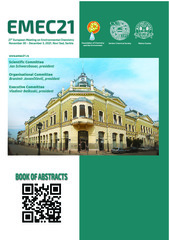Приказ основних података о документу
Determination of Extractable Organic Matter Type from Urban Sediments of Vrbas River (Banja Luka, Bosnia and Herzegovina)
| dc.creator | Stojadinović, Sanja | |
| dc.creator | Veselinović, Gorica | |
| dc.creator | Pržulj, Sanja | |
| dc.creator | Šajnović, Aleksandra | |
| dc.creator | Gajica, Gordana | |
| dc.creator | Štrbac, Snežana | |
| dc.creator | Jovančićević, Branimir | |
| dc.date.accessioned | 2024-02-17T09:14:53Z | |
| dc.date.available | 2024-02-17T09:14:53Z | |
| dc.date.issued | 2021 | |
| dc.identifier.isbn | 978-86-7132-078-8 | |
| dc.identifier.uri | https://cer.ihtm.bg.ac.rs/handle/123456789/7488 | |
| dc.description.abstract | The Vrbas River is an important river ecosystem in Bosnia and Herzegovina with a length of 250 km and catchment areas of 5900 km2 . Before reaching Banja Luka, the Vrbas River passes through a canyon and numerous gorges, which are from 1955 protected by the Law on the Protection of Natural Values. This river flows through many towns and villages along the entire course, but the main anthropogenic influence comes from Banja Luka, one of the largest cities in Bosnia and Herzegovina.The aim of this research was to characterise extractable organic matter of sediments from the Vrbas River in the city area of Banja Luka. Six samples were collected at locations which were selected based on the vicinity of potential sources of anthropogenic pollution: 1 and 3 – sites near bridge and frequent traffic, 2 – city’s promenade, 6 – site in the vicinity of the thermal power plant, 7 – site close to Banja Luka Brewery and the bridge on frequent road, and 8 – site close to the food industry “Vitaminka”. Extractable organic matter was isolated with dichloromethane/ methanol mixture using a Soxhlet apparatus. Hydrocarbons were isolated from the extracts using a column chromatography and analyzed by gas chromatography – mass spectrometry (GC-MS). Detailed analysis of n-alkanes (m/z 71), diterpanes (m/z 123), hopanes (m/z 191) and steranes (m/z 217) was done. The individual peaks were identified by comparison with literature data [1] and based on their mass spectra (library: NIST11). Among saturated hydrocarbons diterpane, 16α(H)phyllocladane is the most dominant component in almost all samples (Fig.1). The exception is a sample 7. This diterpane is followed by n-alkanes with a predominance of higher odd homologues. It indicates predominately native organic matter of Vrbas river sediments, originated mostly from terrestrial plants. That was noticed the predominant presence of native organic material in noticed in samples 2, 3, 6, while the presence of oil type pollutants was confirmed in other samples (1, 7, 8), which are near the bridge and frequent traffic roads. Fig 1. Total ion current (TIC) of saturated fraction. The previous study regarding the contents distribution of heavy metals in these sediments showed that most contaminated samples are at sampling points 2 and 6 [2]. That is not the case with oil contamination pointing to probably different sources of anthropogenic pollution. | sr |
| dc.language.iso | en | sr |
| dc.publisher | Belgrade : Serbian Chemical Society | sr |
| dc.relation | info:eu-repo/grantAgreement/MESTD/inst-2020/200026/RS// | sr |
| dc.relation | info:eu-repo/grantAgreement/MESTD/inst-2020/200168/RS// | |
| dc.rights | openAccess | sr |
| dc.rights.uri | BY | |
| dc.source | Book of Abstracts 21st - European Meeting on Environmental Chemistry | sr |
| dc.title | Determination of Extractable Organic Matter Type from Urban Sediments of Vrbas River (Banja Luka, Bosnia and Herzegovina) | sr |
| dc.type | conferenceObject | sr |
| dc.rights.license | BY | sr |
| dc.citation.spage | 138 | |
| dc.citation.epage | 138 | |
| dc.identifier.rcub | https://hdl.handle.net/21.15107/rcub_cer_7488 | |
| dc.identifier.fulltext | http://cer.ihtm.bg.ac.rs/bitstream/id/29874/EMEC21_138.pdf | |
| dc.type.version | publishedVersion | sr |


